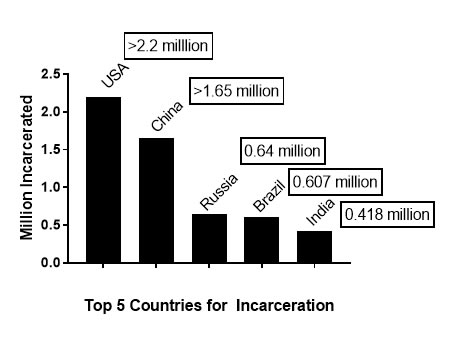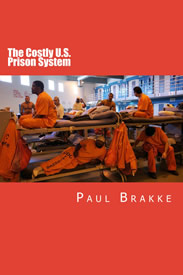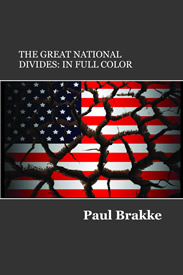The U.S. prison systems costs too much, and the cost would be much less if we reduced the number of incarcerations. We can do that effectively and safely, as I discuss in my book The Costly U.S. Prison System. I’ll talk about some of the highlights here and other blogs in this series.
Why Prisons Are a Bad Investment
While many supporters want more prisons to luck more people up due to harsher enforcement and longer sentences, more prisons may be the worst investment this country can make. Let me explain why.
Former Supreme Court Justices Stephen Breyer and Anthony Kennedy denounced the criminal justice system to a Congressional subcommittee in 2015, noting that it costs approximately $30,000 a year to incarcerate a prisoner in California, compared to $3500 a year for education of schoolchildren. Now multiply that by the number of prison inmates – 2.3 million.
The tab is enormous — well over $60 billion. That’s $600 per U.S. household each year! And that figure is a gross underestimate if you consider the costs to the incarcerated, their families and communities, resulting in some estimating a final cost estimate of $1 trillion.
Should we try harder to rehabilitate prisoners, so they can become productive, contributing members of society? Or do we really want to provide many of them who could be safely released free room and board behind bars at our expense?
It’s certainly true that we have to lock up the worst in our society to keep them from harming us. But we have been doing too much of that, and too many of these criminals aren’t the worst in our society. We’ve run out of prison space. We’re constantly constructing new prisons, and the prisoners we release keep on offending, winding back up in the slammer as recidivists (repeat offenders) in no time.
Incarcerations must decrease. The high recidivism rate has to be lowered. And there are other ways to improve the prison and correctional systems, reduce the number of prison inmates, and prepare them for successful re-entry back into society. That’s a tall order, but I’ll start with some highlights of the problem and what we should do about it in this blog series. Further details on this problem and ways to fix the system are in my book The Costly U.S. Prison System.
The High Rate of Incarceration in the U.S.
How high is the U.S. incarceration rate? Over 2 million are currently in prison, and the U.S. leads the world in incarcerations, as shown on the chart below, though most U.S. citizens are probably unaware of this.
Only China with 1.65 million incarcerated comes close, and the other top three countries with high incarceration rates — Russia, Brazil, and India — don’t even come close.
For a country that prides itself on its human rights record and seriously criticizes countries like Russia and China for their poor treatment of people, we should examine ourselves closely to make sure we are not guilty of hypocrisy. Maybe the charity Human Rights Watch ought to concern itself with America First. We could be accused of having our own gulag, given our horrendous incarceration record.
Why Do We Have So Many Prisoners?
A common belief, pushed by the media is that we have so many more prisoners because we are a much more violent nation than others. But this isn’t the case. To illustrate, the chart below indicates that Russia and Brazil have a much higher murder rate than we do.
Therefore, there is no real excuse for the vast number of prisoners we have incarcerated. We have imprisoned so many millions in response to a crime wave that began in the 1960s. That may have helped reduce crime levels, but we still haven’t fixed the crime problem sufficiently, and we have now added the additional problem that incarceration compounds the social ill that plagues our cities.
That’s because this extensive incarceration has further eroded the social structure of impoverished urban black communities, and this will continue to foster crime for decades to come unless we treat the condition that leads to criminal behavior — much of it the result of poverty in the inner cities.
While some smaller countries approach the U.S. rate of incarceration, no country of over a million inhabitants does. That’s because proportionately, we are putting more of our criminals in prison, even for nonviolent crimes, than other countries. And ironically, many of these are third-world less developed countries that have a higher low-income and impoverished population compared to us.
Ironically, we Americans pride ourselves on being first in many things, but incarceration should not be one of those. We experience similar levels of crime as European countries, but more violent crime (homicide, rape,robbery and assault), and victims are more likely die in the U.S. It is likely that the fear of violent crime has led us to demand tougher punishment.
The result is on average about a six times higher incarceration rate than Europe has. And as shown in the chart below, when all different types of punishments are included — jail, parole, or probation in addition to being in prison — the U.S. far exceeds even the sum of the four other biggest countries: China, Russia, Brazil and India.
So what should we do about this problem? That’s what I’ll talk about in the next few blogs in this series.
Paul Brakke is a scientist based in the Little Rock, Arkansas area. He became interested in studying the criminal justice system when his life was turned upside down after his wife was falsely accused of aggravated assault for trying to run some kids over with her car, since the kids and some neighbors wanted her out of the neighborhood.
Eventually, they were forced to move as part of a plea agreement, since otherwise, Brakke’s wife faced a possible 16 year jail sentence if the case went to trial and she lost.
He has previously told his wife’s story in American Justice?, along with a critique of the criminal justice system. That book’s website is at americanjusticethebook.com.
He founded American Leadership Books after he began investigating the criminal justice system in more depth. Thus far, five more of his books have been published by American Leadership Books.








